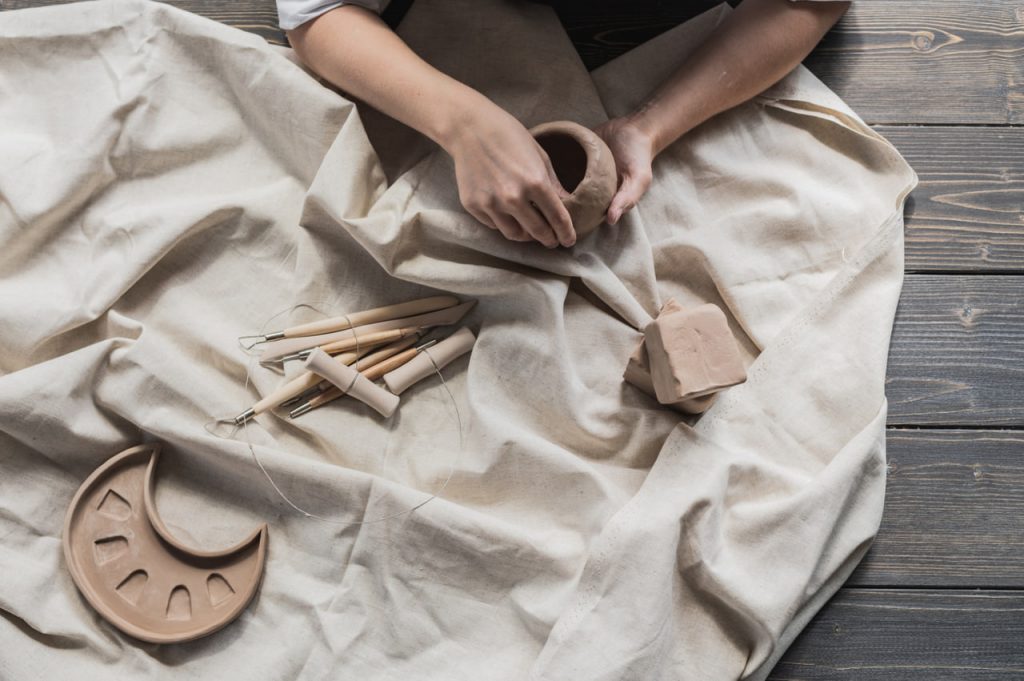As the world becomes more conscious of its environmental impact, sustainability is no longer just a buzzword but a necessity in every aspect of our lives—especially in creative fields like textile crafting. Textile crafting, from sewing and quilting to embroidery and weaving, often involves materials and processes that can have a significant environmental footprint. However, the beauty of crafting lies in its potential to make a positive impact when approached with eco-friendly practices. Whether you’re a seasoned crafter or a beginner, there are countless ways you can reduce your environmental footprint while still enjoying your textile projects.
In this blog, we will explore various sustainable textile crafting practices, from choosing eco-friendly materials to adopting greener techniques, that will help you create beautiful, thoughtful, and environmentally responsible pieces.
1. Choosing Sustainable Fabrics
The first and most significant step toward sustainable textile crafting is selecting eco-friendly fabrics. Traditional fabrics, especially synthetic ones like polyester and nylon, are made from non-renewable resources and can take hundreds of years to decompose. To reduce the environmental impact of your projects, opt for fabrics that are more sustainable and have a lower environmental footprint.
Sustainable Fabric Options:
- Organic Cotton: Unlike conventional cotton, organic cotton is grown without the use of synthetic pesticides or fertilizers. It promotes soil health and uses less water, making it a more sustainable choice for sewing, quilting, and other textile crafts.
- Linen: Made from the flax plant, linen is one of the oldest textiles known to man. It is durable, biodegradable, and requires minimal water and pesticides to grow. Linen is also breathable, making it a great choice for garments and home decor items.
- Hemp: Hemp is a highly sustainable fiber that requires little water and no pesticides. It’s naturally resistant to pests, making it a great alternative to cotton. Hemp fabrics are durable and versatile, perfect for home decor items like cushions, tablecloths, and wall hangings.
- Recycled Fabrics: Using fabrics made from post-consumer materials (like recycled polyester or repurposed cotton) is a great way to give old textiles a second life. These fabrics are often made from waste such as plastic bottles or discarded clothes, helping to reduce landfill waste and the need for virgin materials.
- Tencel (Lyocell): Tencel is a biodegradable fabric made from sustainably sourced wood pulp, usually from eucalyptus trees. The production process uses less water and energy compared to conventional fabric manufacturing. It’s smooth, breathable, and perfect for making clothing or soft furnishings.
- Wool: Wool is a natural, renewable fiber that is biodegradable. When sourced from responsible farms that use ethical practices, it can be a highly sustainable option for your crafting projects. Look for wool that’s certified by ethical wool standards or sourced from farms with low environmental impacts.
Eco-Friendly Tip:
When choosing fabric, always check for certifications like Global Organic Textile Standard (GOTS), OEKO-TEX Standard 100, or Fair Trade certification to ensure the fabric has been produced using environmentally responsible and ethical methods.
2. Repurposing and Upcycling Materials
Upcycling—transforming old or discarded items into something new and useful—is a fantastic way to practice sustainable textile crafting. Instead of buying new fabrics, look for old garments, linens, or textiles that can be repurposed into something creative. This reduces the demand for new materials and diverts waste from landfills.
Ideas for Repurposing:
- Old Clothes: Turn worn-out shirts, jeans, or dresses into new garments or home decor items like cushions, bags, or wall art. For example, old denim can be transformed into quilt squares or tote bags, while vintage shirts can become patchwork blankets.
- Fabric Scraps: Save all your fabric scraps—whether from cutting patterns or leftover projects—and turn them into smaller projects like patchwork quilts, coasters, or appliqué designs. You can also use small pieces for embroidery or embroidery hoop art.
- Old Bed Linens and Towels: Old sheets and towels can be used for quilting, making reusable cloth napkins, or sewing eco-friendly cleaning cloths. They’re also perfect for creating soft storage baskets or as the base for embroidery projects.
- Vintage Textiles: Look for vintage fabrics in thrift stores, flea markets, or family heirlooms. These often have unique patterns, textures, and histories, and can be repurposed into anything from decorative pillows to clothing.
Eco-Friendly Tip:
Instead of discarding worn items, consider hosting a fabric swap with friends or fellow crafters. This can be a great way to exchange unused materials and find new treasures for your projects while keeping things out of landfills.
3. Using Eco-Friendly Dyes and Finishes
Traditional fabric dyes and finishes often contain harmful chemicals that are not only toxic but can also end up polluting water sources. However, there are many eco-friendly dyeing methods and natural finishes that can make your textile crafts more sustainable.
Natural Dyes:
- Plant-Based Dyes: Many plants, flowers, fruits, and vegetables can be used to create natural dyes. Examples include indigo for blue, turmeric for yellow, or beetroot for pink. Using natural dyes reduces the need for synthetic chemicals and creates beautiful, one-of-a-kind colors.
- Avocado Pit and Skins: Did you know that avocado pits and skins can be used to create a beautiful blush-pink dye? This is a great way to reuse food waste and create a soft, natural color on fabrics.
- Coffee and Tea: Both coffee and tea can be used to dye fabrics naturally, creating warm, earthy tones. This is a perfect way to recycle your used coffee grounds or tea bags, giving them a second life as a fabric dye.
- Beetroot and Pomegranate: These are wonderful natural dye sources that yield deep reds and oranges, adding rich tones to your textiles.
Eco-Friendly Finishes:
- Beeswax: Use beeswax to make your own eco-friendly fabric wraps or finish fabrics for bags, wraps, or other items. Beeswax is biodegradable and reusable, making it a sustainable option for finishing textiles.
- Starch Alternatives: Instead of using store-bought fabric starch, which often contains chemicals, you can create your own natural starch solution with cornstarch and water. This is especially useful when crafting home decor items like tablecloths, napkins, or curtains.
Eco-Friendly Tip:
If you’re looking for an eco-friendly fabric spray, opt for non-toxic, plant-based fabric sprays or essential oils as alternatives to chemical-laden products.
4. Minimal Waste Crafting
In textile crafting, especially with sewing, it’s easy to accumulate waste. However, there are several ways to minimize waste and use materials more efficiently, so your projects are as eco-friendly as possible.
Ways to Minimize Waste:
- Pre-plan Your Projects: When cutting fabric, be sure to plan carefully and minimize the amount of scrap fabric. Use a pattern to ensure you’re using your fabric to its fullest potential.
- Use a Rotary Cutter: A rotary cutter can be more precise than scissors, reducing the likelihood of uneven edges and wasted fabric.
- Repurpose Scraps: As mentioned earlier, save your fabric scraps for smaller projects, quilting, or even creating fabric scraps that can be used as stuffing for cushions or toys.
- Make Reusable Items: Craft items that reduce single-use waste, such as reusable shopping bags, cloth napkins, produce bags, and fabric gift wrap.
Eco-Friendly Tip:
If you have fabric scraps you can’t use, consider donating them to a local charity, school, or craft group. Many organizations accept textile donations, and they might be able to repurpose your scraps for community projects.
5. Sustainable Sewing Practices
Sewing is one of the most popular textile crafts, and there are several ways to make your sewing practice more sustainable. These tips can help reduce waste, use eco-friendly materials, and ensure that your craft is contributing positively to the environment.
Sustainable Sewing Practices:
- Buy Quality Tools: Invest in high-quality tools that last longer and reduce the need for replacements. For example, invest in sharp, durable scissors, a sturdy sewing machine, and reusable pins to reduce waste.
- Use Natural Thread: Synthetic threads are often made from plastic, which is not biodegradable. Instead, opt for natural threads made from cotton, linen, or silk, which are biodegradable and more sustainable.
- Wash Less: Wash your finished projects less often. Over-washing fabrics, especially synthetics, leads to microplastic pollution in the water. When washing, use a microfiber bag to capture synthetic fibers or opt for natural fabrics that break down more easily in the environment.
Eco-Friendly Tip:
Try to repair and upcycle old garments and fabric projects instead of discarding them. Patch up holes, repurpose old clothing into new items, or upcycle fabric to create something entirely different.

